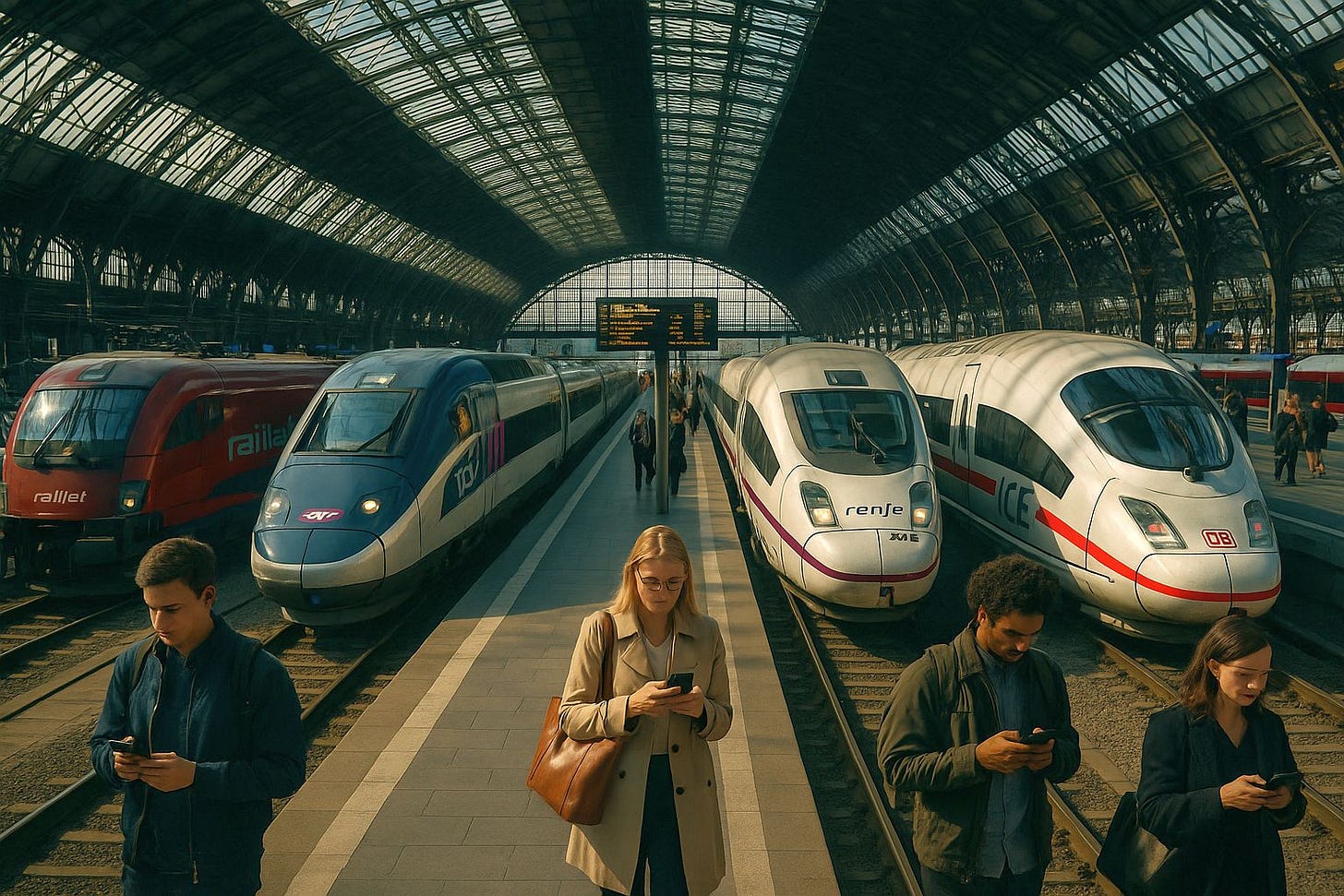Why Europe’s Rail Booking Chaos Won’t Fix Itself

As the European Commission promises a single digital rail ticket for the fifth consecutive year, new polling reveals 61% of long-distance passengers have abandoned bookings due to complexity. The fragmentation isn’t a technical problem—it’s a business model.
A passenger booking Nice to Lisbon faces a three-ticket puzzle: SNCF to the Spanish border, Renfe across Spain, CP into Portugal. Each operator runs independent pricing algorithms. Each connection requires manual verification. If the first train runs late and the passenger misses the second, no unified passenger rights apply. A Ryanair flight takes one click.
QUICK TAKE
The issue: 30+ national operators control separate ticketing systems, forcing passengers booking Milan-Copenhagen to navigate 4-5 websites with no integrated connections or passenger rights
The numbers: 61% booking abandonment (YouGov poll, 7 EU countries) • Single Digital Booking & Ticketing Regulation promised 2025, removed from Commission Work Programme • High-speed network doubled in decade, cross-border booking still manual
Why it matters: Rail operators have economic incentives to maintain fragmentation—eliminating it would trigger direct cross-border price competition and erode margins
The European Commission identified this fragmentation as “THE biggest problem” blocking modal shift to rail. President von der Leyen promised in July 2024 that Europeans would soon “buy one single ticket on one single platform” with full passenger rights protection. By February 2025, the Single Digital Booking & Ticketing Regulation (SDBTR) had been removed from the official Commission Work Programme, classified internally as a “complex file requiring significant technical work.”
Meanwhile, the YouGov poll commissioned by Transport & Environment shows 61% of long-distance rail passengers across seven EU countries have given up on bookings because the process was too complicated.
Is This Really About Technology?
The technical barriers are largely solved. Ready-made standards exist: NetEX for exchanging train schedule data, OSDM for harmonised sales protocols. The IRG-Rail regulatory body identified the real obstacles in 2021: commercial requirements (who gets to sell which tickets?), system fragmentation driven by business interests, and digital infrastructure choices made to maintain competitive advantage.
Even neighbouring operators don’t share full ticketing inventory. Renfe cannot sell a ticket from Badajoz—Spanish territory—to Lisbon, despite the two cities being connected by direct service. The data exists. The infrastructure works. The business incentive to integrate doesn’t.
Railway operators maintain pricing power through segmentation. If all tickets integrated into transparent through-pricing, passengers could compare end-to-end costs across routes and operators. Currently, each operator sets independent yield management on their network segment, protected from direct price comparison. Research on competitive entry in rail markets shows this reduces incumbent pricing power—exactly what established operators want to avoid.
Data control reinforces the incentive structure. Ticket distribution data reveals passenger flow patterns, demand elasticity, and booking behavior—commercial intelligence operators are reluctant to share with competitors or regulators. Legacy IT systems require expensive replacement; API integration demands investment with uncertain return when the status quo protects margins.
The Community of European Railways (CER) warned regulators explicitly: “Railway undertakings operate on small margins with high fixed costs, so any regulatory intervention that decreases margins will result in diminishing services.” Translation: forcing data sharing and eliminating segmented pricing reduces revenue without cutting costs, so operators will resist.
The Strategic Fork
Some operators are integrating voluntarily. ÖBB and DB are implementing the OSDM (Open Sales and Distribution Model) from autumn 2025, enabling better cross-border data access for journeys like Vienna-Berlin. However, passengers still purchase separate tickets, and unified passenger rights protection remains unresolved—precisely the gap the proposed SDBTR regulation aims to close. SBB ranks highest in Transport & Environment’s booking experience assessments.
These early movers gain competitive advantage: customers who experience improved booking with one operator develop loyalty that survives regulatory changes. For infrastructure managers, fragmentation blocks effective capacity planning. Without unified data on passenger flows across borders, optimizing network-level investment becomes guesswork. Public money pours into high-speed lines that don’t translate to modal shift because the booking experience drives passengers back to cars and planes.
The EU’s climate targets require 50% freight growth on rail by 2030 and significant passenger modal shift. Neither happens if booking complexity persists. The high-speed network has doubled in the last decade. Journey times have fallen. But 61% booking abandonment means infrastructure investment isn’t converting to passenger behavior change.
Operators face a choice. They can lead integration—building competitive advantage through superior customer experience and preparing for inevitable regulation with systems that minimize disruption. Or they can resist until regulation forces sudden change, creating margin squeeze without time to adapt. The standards exist. The technology works. The question isn’t whether European rail booking will integrate. It’s whether operators choose to control the transition or have it imposed.
WHAT THIS MEANS
For operators: Early voluntary integration builds competitive advantage and prepares systems for inevitable regulation; resistance protects short-term margins but risks sudden forced compliance
For suppliers: OSDM compliance investment likely mandatory within 3-5 years; platform providers face opportunity if APIs mandated, risk if EU builds centralized alternative
For policymakers: SDBTR delay reflects political complexity, not technical impossibility; passenger rights revision addresses symptoms while fragmentation persists

